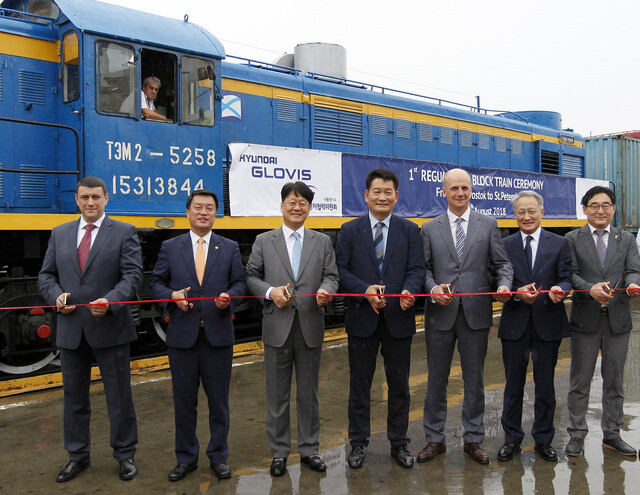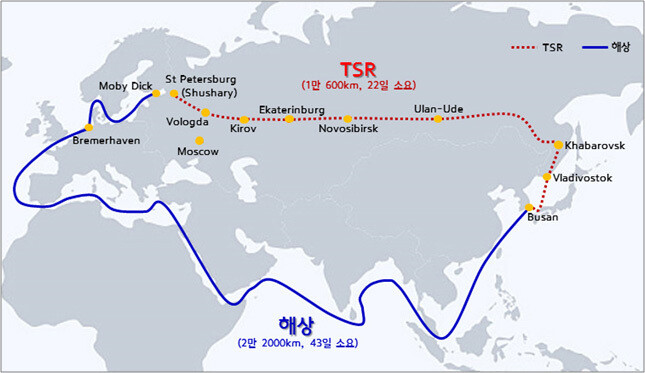hankyoreh
Links to other country sites 다른 나라 사이트 링크
Hyundai Glovis introduces non-stop Trans-Siberian freight train from Vladivostok to St. Petersburg

Hyundai Glovis is introducing regular nonstop express freight train service over the 10,000 kilometers of the Trans-Siberian Railway (TSR) between the Russian cities of Vladivostok and Saint Petersburg. Observers are watching to see if the service represents a turning point in parlaying the mood of inter-Korean reconciliation into expansions in northern distribution efforts.
Hyundai Glovis announced on Aug. 14 that it had held a commemorative event for the departure of 64 freight containers from Vladivostok, marking the beginning of regular express freight train service in Siberia. The service involves one “block train” (express freight train) per week traveling on the TSR, a 10,000-km railway stretching between Vladivostok and Saint Petersburg. While slower distribution service was previously provided over multiple stops along the railway’s length, this marks the first regular service involving a nonstop block train.
“With no stops along the way, distribution efficiency can be maximized and the distribution distance and time can be reduced by around half from the previous marine transportation using the southern route over the Indian Ocean, Suez Canal, and Mediterranean Sea,” Hyundai Glovis explained.

As a first shipment that morning, Hyundai Glovis loaded 64FEU (forty-foot equivalent units) of knock-down (KD) automobile parts ordered by a Hyundai Motor factory in Russia for shipment from Vladivostok. The freight train was scheduled to arrive 9,600 km away at Shushary Station in southern Saint Petersburg twelve days later on Aug. 26.
A block train is a dedicated train system with an express linkage between the freight’s origin and destination and no stops in between. It offers the advancement of maximum distribution efficiency, as freight can be shipped straight to its destination once loaded. Existing freight transport from Vladivostok on the TSR operates through irregularly scheduled single trains that stop at multiple destinations and terminals along the way; shipments are sent mainly to Saint Petersburg and inland Moscow, which is also the final destination for most of the block train service currently available.
Considered the “gateway to Russia” and a hub of land and sea transportation, Saint Petersburg is home to Russia’s largest trade port.
The method adopted by Hyundai Glovis involved loading freight onto container ships at Busan Port and transporting them 970km over the water to Vladivostok, where they are transferred to the TSR and shipped to Saint Petersburg through the rail service of Russian distribution company FESCO. The process takes a total of 22 days: two days from Busan to Vladivostok; eight days for unloading, customs clearance, and reloading in Vladivostok; and 12 days from Vladivostok to Shushary Station near Saint Petersburg.
Reduction of distance by switching from sea to land transport
In the past, Hyundai Glovis chiefly used sea-based transportation to supply goods to Hyundai factories in Russia. Freight was loaded onto container ships in Busan for transport over the southern sea route to Moby Dik Terminal near Saint Petersburg, where it was transferred to trucks that supplied it to the factories over land. The process involved transporting the freight 22,000km over the sea – a 43-day process. The TSR-based distribution Hyundai Glovis is now introducing is poised to reduce the distance and time by roughly half from sea-based transport.
The ceremony at Vladivostok Station was attended by Hyundai Glovis CEO Kim Jung-hoon, Democratic Party lawmaker and Presidential Committee on Northern Economic Cooperation chairman Song Young-gil, South Korean consul general in Vladivostok Lee Seok-bae, and Primorsky Krai vice governor Dmitry Fyodorovich.
By Hong Dae-seon, staff reporter
Please direct comments or questions to [english@hani.co.kr]

Editorial・opinion
![[Guest essay] The real reason Korea’s new right wants to dub Rhee a founding father [Guest essay] The real reason Korea’s new right wants to dub Rhee a founding father](https://flexible.img.hani.co.kr/flexible/normal/500/300/imgdb/original/2024/0423/8317138574257878.jpg) [Guest essay] The real reason Korea’s new right wants to dub Rhee a founding father
[Guest essay] The real reason Korea’s new right wants to dub Rhee a founding father![[Column] ‘Choson’: Is it time we start referring to N. Korea in its own terms? [Column] ‘Choson’: Is it time we start referring to N. Korea in its own terms?](https://flexible.img.hani.co.kr/flexible/normal/500/300/imgdb/original/2024/0423/3617138579390322.jpg) [Column] ‘Choson’: Is it time we start referring to N. Korea in its own terms?
[Column] ‘Choson’: Is it time we start referring to N. Korea in its own terms?- [Editorial] Japan’s rewriting of history with Korea has gone too far
- [Column] The president’s questionable capacity for dialogue
- [Column] Are chaebol firms just pizza pies for families to divvy up as they please?
- [Column] Has Korea, too, crossed the Rubicon on China?
- [Correspondent’s column] In Japan’s alliance with US, echoes of its past alliances with UK
- [Editorial] Does Yoon think the Korean public is wrong?
- [Editorial] As it bolsters its alliance with US, Japan must be accountable for past
- [Guest essay] Amending the Constitution is Yoon’s key to leaving office in public’s good graces
Most viewed articles
- 1[Editorial] Japan’s rewriting of history with Korea has gone too far
- 2Samsung barricades office as unionized workers strike for better conditions
- 3[Column] ‘Choson’: Is it time we start referring to N. Korea in its own terms?
- 4Why Korea shouldn’t welcome Japan’s newly beefed up defense cooperation with US
- 5[Column] The clock is ticking for Korea’s first lady
- 6[Guest essay] The real reason Korea’s new right wants to dub Rhee a founding father
- 7Korean government’s compromise plan for medical reform swiftly rejected by doctors
- 8[Reporter’s notebook] Did playing favorites with US, Japan fail to earn Yoon a G7 summit invite?
- 9[Column] The president’s questionable capacity for dialogue
- 10Senior doctors cut hours, prepare to resign as government refuses to scrap medical reform plan